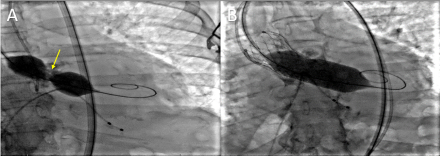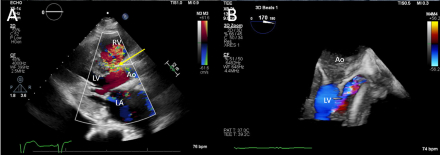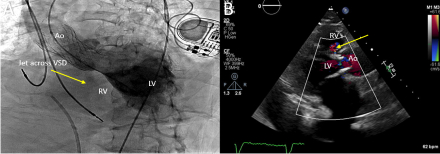Final ID: MDP1356
A Rare Cause of Recurrent Heart Failure Exacerbations After Transcatheter Aortic Valve Replacement: Ventricular Septal Defect and Significant Paravalvular Leak
Abstract Body (Do not enter title and authors here):
Introduction: Ventricular septal defects (VSD) have been reported in <1% of cases following transcatheter aortic valve replacement (TAVR). A retrospective record review of VSD cases occurring after all TAVRs performed between January 2012 and September 2020 at one urban US tertiary hospital showed 0.37% incidence of these complications, mostly with small and restrictive VSD.
Case Description: An 80-year-old woman with history of hypertension, HFpEF, and TAVR 8 months prior for severe aortic stenosis (AS) at an outside hospital presented with worsening dyspnea and peripheral edema over the past month. Blood pressure was 148/53mmHg, heartrate 83bpm, oxygen saturation 98% and auscultation revealed a harsh holosystolic murmur 4/6 loudest at left sternal border and bibasilar rales. Chest X-ray showed pulmonary edema and bilateral pleural effusions. NT-proBNP was 17,000pg/ml and troponin-I was negative. Echocardiogram showed EF55-60%, a membranous VSD, severe pulmonary hypertension, and moderate paravalvular leak (PVL). Coronary angiogram showed non-obstructive disease. Right heart catheterization confirmed significant left to right shunting.
Treatment/Outcomes: Cardiothoracic surgery was consulted for multidisciplinary evaluation, and joint recommendation was for surgical aortic valve replacement and VSD closure which was successfully performed. One month follow-up echocardiogram showed normal aortic valve gradient without PVL and normal right ventricular pressure.
Discussion/Conclusion: Numerous potential risks such as severe and uneven calcification of the native valve, an elliptic aortic annulus, excessive valve sizing, or elevated valve placement can lead to VSD. A recurrent element in many of these instances involves direct trauma to the septum caused by the implanted valve, exacerbated by subsequent annulus dilation. The presence of PVL is common post-TAVR and is an established independent prognostic factor, while VSD post-TAVR is uncommon, but may be associated with low implantation position relative to the aortic annulus or post-implantation balloon dilatation. Rarely, worsening VSD may require operative management. In this case, the improvement of heart failure symptoms and echocardiogram parameters after transthoracic surgery confirmed successful repair.
Introduction: Ventricular septal defects (VSD) have been reported in <1% of cases following transcatheter aortic valve replacement (TAVR). A retrospective record review of VSD cases occurring after all TAVRs performed between January 2012 and September 2020 at one urban US tertiary hospital showed 0.37% incidence of these complications, mostly with small and restrictive VSD.
Case Description: An 80-year-old woman with history of hypertension, HFpEF, and TAVR 8 months prior for severe aortic stenosis (AS) at an outside hospital presented with worsening dyspnea and peripheral edema over the past month. Blood pressure was 148/53mmHg, heartrate 83bpm, oxygen saturation 98% and auscultation revealed a harsh holosystolic murmur 4/6 loudest at left sternal border and bibasilar rales. Chest X-ray showed pulmonary edema and bilateral pleural effusions. NT-proBNP was 17,000pg/ml and troponin-I was negative. Echocardiogram showed EF55-60%, a membranous VSD, severe pulmonary hypertension, and moderate paravalvular leak (PVL). Coronary angiogram showed non-obstructive disease. Right heart catheterization confirmed significant left to right shunting.
Treatment/Outcomes: Cardiothoracic surgery was consulted for multidisciplinary evaluation, and joint recommendation was for surgical aortic valve replacement and VSD closure which was successfully performed. One month follow-up echocardiogram showed normal aortic valve gradient without PVL and normal right ventricular pressure.
Discussion/Conclusion: Numerous potential risks such as severe and uneven calcification of the native valve, an elliptic aortic annulus, excessive valve sizing, or elevated valve placement can lead to VSD. A recurrent element in many of these instances involves direct trauma to the septum caused by the implanted valve, exacerbated by subsequent annulus dilation. The presence of PVL is common post-TAVR and is an established independent prognostic factor, while VSD post-TAVR is uncommon, but may be associated with low implantation position relative to the aortic annulus or post-implantation balloon dilatation. Rarely, worsening VSD may require operative management. In this case, the improvement of heart failure symptoms and echocardiogram parameters after transthoracic surgery confirmed successful repair.
More abstracts on this topic:
Aberrant Trans- and De- Nitrosylation Underpins Nitrosative Stress in Cardiometabolic HFpEF
Li Zhen, Borch Jensen Martin, Vondriska Thomas, Lefer David, Gehred Natalie, Gromova Tatiana, Lapenna Kyle, Sharp Thomas, Chen Jingshu, Shambhu Smitha, Yu Xiaoman, Goodchild Traci
A RETRO-ENANTIOMER OF ANGIOTENSIN-(1-9) PREVENTS THE DEVELOPMENT OF HEART FAILURE WITH PRESERVED EJECTION FRACTION.Ocaranza Maria Paz, Jimenez Veronica, Yanez Osvaldo, Jalil Jorge, Venegas Camilo, Candia Camila, Hermoso Marcela, Gabrielli Luigi, Morales Javier, Oyarzun Felipe, Torres Cristian, Lillo Pablo



